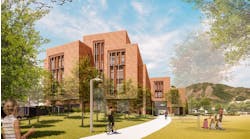Architects try to design buildings that enhance an active learning experience by fomenting a sense of inquiry and discovery. Instead of warehouses of classrooms, buildings are seen as laboratories for learning. They seek to create environments that actively engage occupants across a spectrum of activities from group projects to individual pursuits.
Rather than pursuing traditional models of a lead instructor teaching a group of students, schools and universities should encourage students to become active learners who participate in a broader culture of inquiry: with guidance, learning from each other and their own activities. These models narrow the divide between students and faculty, and help establish a culture of shared discovery.
Engaging minds
As more teachers become guides to a student's education and as more students become lifelong learners, the classroom has become only one of many points of contact. Designers increasingly are providing a variety of spaces with a spectrum of possibilities for group and individual learning. Areas beyond the classroom are constructed intentionally for teachers to encounter students in "student spaces" and for students to encounter teachers in "faculty spaces."
Those areas include classrooms, and formal and informal spaces for group learning, single-student learning, and private faculty-student tutoring. In new pilot programs such as the "Schoolofone," many of these space types are incorporated into a single classroom for younger learners. There are multiple modalities by which students learn. The responsibility falls to educators to provide the varied environments that enable each student to be successful.
Educational environments increasingly are designed to provoke questioning and discovery, and to actively engage the minds of students. The use of interior transparency has been increasing; it increases daylight, improves supervision and fosters a greater sense of community, and it provides visual connections and access to the building systems that support the classroom environments.
These school environments, in a sense, recognize the technology and the building systems as teachings opportunities, and the "invisible hand" supporting the student spaces becomes an active part of the environment. This transparency into prep spaces, mechanical rooms, elevators and server rooms provides a teaching environment more democratic and more demonstrative of the complex environments in which we all exist. The intent is clear: to create an atmosphere of questioning (and demonstration) about our surroundings rather than one pre-prioritized and concealed.
Featured spaces
This evolution of buildings from a neutral framework for classrooms to participant is responsible for a variety of new features that are intended to provoke critical thinking, not only about the built environments, but also about the larger environment.
A recent project in Massachusetts used a simple oculus cut into the roof and an opening that was engineered to enable an orb of sunlight to be projected onto the floor of a student commons at exactly noon each day. Over the course of the year, this circle of sunlight then cumulatively traces the solar analemma across the floor of the space. The students' corresponding mission over the building's first year was to mark the position of the light at noon each day. At the beginning of the second year, the resulting figure-eight of the sun's path (the analemma) was carved into the common's floor and inlaid with a reflective terrazzo. Thus, a student space that could have housed passively the daily ebb and flow of student gatherings instead actively captures and describes the complex geometry of the Earth's relation to the sun, the daily rotation of the Earth and the tilted angle of the Earth's rotation. Each year, the building presents to new students the question and the possibility of discovering the interrelation of these systems.
This building also has solar and lunar telescopes on a terrace. These telescopes project real-time ultraviolet images of the sun and visual spectrum images of the moon onto large walls at the building's front entry. These evolving and changing images, each with their own rhythm, become part of students' daily experience. The lunar cycle, the static textured surface of the moon and the dynamic violent surface of the sun again become the points of engagement and questioning.
By encouraging occupants to engage the environment, education buildings can instill an interest in seeing the world in new ways and encourage students to think beyond preconceived ideas.
Alfieri, AIA, LEED AP, is an associate principal in Perkins + Will, Perkins+Will's New York office, where he leads a range of higher-education and science + technology projects. Kirkham, AIA, LEED AP BD+C, is an associate principal and award-winning senior designer with 20 years of experience in educational, residential and commercial projects. They can be reached at [email protected] and [email protected]

